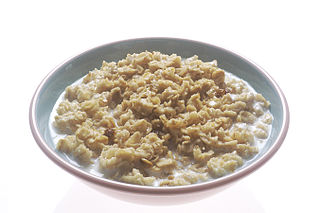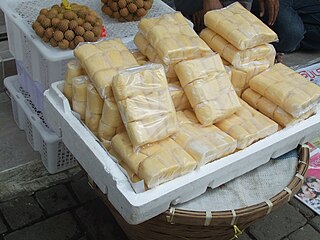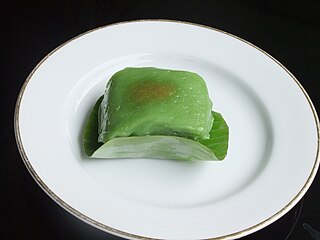
Porridge is a food made by heating or boiling ground, crushed or chopped starchy plants, typically grain, in milk or water. It is often cooked or served with added flavourings such as sugar, honey, fruit, or syrup to make a sweet cereal, or it can be mixed with spices, meat, or vegetables to make a savoury dish. It is usually served hot in a bowl, depending on its consistency. Oat porridge, or oatmeal, is one of the most common types of porridge. Gruel is a thinner version of porridge and congee is a savoury variation of porridge of Asian origin.

Glutinous rice is a type of rice grown mainly in Southeast and East Asia, and the northeastern regions of South Asia, which has opaque grains, very low amylose content, and is especially sticky when cooked. It is widely consumed across Asia.

Malay cuisine is the traditional food of the ethnic Malays of Southeast Asia, residing in modern-day Malaysia, Indonesia, Singapore, Brunei, Southern Thailand and the Philippines as well as Cocos Islands, Christmas Island, Sri Lanka and South Africa.

Rice pudding is a dish made from rice mixed with water or milk and commonly other ingredients such as sweeteners, spices, flavourings and sometimes eggs.

Kuih are bite-sized snack or dessert foods commonly found in Southeast Asia and China. It is a fairly broad term which may include items that would be called cakes, cookies, dumplings, pudding, biscuits, or pastries in English and are usually made from rice or glutinous rice. In China, where the term originates from, kueh or koé (粿) in the Min Nan languages refers to snacks which are typically made from rice but can occasionally be made from other grains such as wheat. The term kuih is widely used in Malaysia, Brunei, and Singapore, kueh is used in Singapore and Indonesia, kue is used in Indonesia only, all three refer to sweet or savoury desserts.

Tapai is a traditional fermented preparation of rice or other starchy foods, and is found throughout much of Southeast Asia, especially in Austronesian cultures, and parts of East Asia. It refers to both the alcoholic paste and the alcoholic beverage derived from it. It has a sweet or sour taste and can be eaten as is, as ingredients for traditional recipes, or fermented further to make rice wine. Tapai is traditionally made with white rice or glutinous rice, but can also be made from a variety of carbohydrate sources, including cassava and potatoes. Fermentation is performed by a variety of moulds including Aspergillus oryzae, Rhizopus oryzae, Amylomyces rouxii or Mucor species, and yeasts including Saccharomyces cerevisiae, and Saccharomycopsis fibuliger, Endomycopsis burtonii and others, along with bacteria.

Bubur cha cha, also spelled as bubur cha-cha or dubo jiajie, is a Betawi and Malay dessert and breakfast dish in Indonesian cuisine, Malaysian cuisine, Singaporean cuisine and Phuket cuisine (Thailand) prepared using pearled sago, sweet potatoes, yams, bananas, coconut milk, pandan leaves, sugar and salt. Grated coconut, coconut cream and water can be used as additional ingredients. The ingredients are cooked in coconut milk, and the dish can be served hot or cold. Bubur cha cha is also sold as a street food in many parts of Southeast Asia.

Chè is any traditional Vietnamese sweet beverage, dessert soup or stew, or pudding. Chè includes a wide variety of distinct soups or puddings. Varieties of Chè can be made with mung beans, black-eyed peas, kidney beans, tapioca, jelly, fruit, and coconut cream. Other types are made with ingredients such as salt, aloe vera, seaweed, lotus seed, sesame seed, sugar palm seeds, taro, cassava and pandan leaf extract. Some varieties, such as chè trôi nước, may also include dumplings. Chè are often prepared with one of a number of varieties of beans, tubers, and/or glutinous rice, cooked in water and sweetened with sugar. In southern Vietnam, chè are often garnished with coconut creme.

Javanese cuisine is the cuisine of Javanese people, a major ethnic group in Indonesia, more precisely the province of Central Java, Yogyakarta and East Java.

Serabi, surabi, or srabi is a traditional Balinese–Javanese snack, similar to a pancake, made of a rice flour-based batter with coconut milk or coconut cream and shredded coconut as an emulsifier. Most traditional serabi tastes sweet, as these pancake-like desserts are usually eaten with kinca, a golden-brown coconut sugar syrup in the Sundanese culinary tradition.

Es doger is an Indonesian coconut milk-based shaved ice beverage with pinkish color often served as a dessert. It is a specialty of Bandung, West Java. The main, or base, part is sugared sweet coconut milk-based ice in pink syrup, served with pacar cina merah delima, avocado, cassava tapai, ketan hitam tapai, jackfruit, diced bread and condensed milk. The condensed milk can be plain (white), or chocolate flavoured. Es doger gains its pinkish color from rozen (rose) syrup, cocopandan syrup, or pink food coloring. Es doger is commonly sold by travelling vendor carts in major Indonesian cities, mainly in Bandung, Jakarta, Malang and Surabaya.

Wajik or wajid, also known as pulut manis, is a traditional glutinous sweet made with rice, sugar and coconut milk. It is an Indonesian kue, and a kuih of Brunei, Singapore and Malaysia.

Betawi cuisine is rich, diverse and eclectic, in part because the Betawi people that create them were composed from numbers of regional immigrants that came from various places in the Indonesian archipelago, as well as Chinese, Indian, Arab, and European traders, visitors and immigrants that were attracted to the port city of Batavia since centuries ago.

Mango sticky rice is a traditional Southeast Asian and South Asian dessert made with glutinous rice, fresh mango and coconut milk, and eaten with a spoon or the hands.

Kue bugis is Indonesian kue or traditional snack of soft glutinous rice flour cake, filled with sweet grated coconut. The name is suggested to be related to Bugis ethnic group of South Sulawesi as their traditional delicacy, and it is originated from Makassar. In Java the almost identical kue is called kue mendut or Koci Koci. Kue bugis, together with kue lapis and nagasari are among popular kue or Indonesian traditional sweet snacks, commonly found in Indonesian traditional marketplace as jajan pasar.

Bubur kacang hijau, abbreviated burjo, is a Southeast Asian sweet porridge (bubur) made from mung beans, coconut milk, and palm sugar or cane sugar. The beans are boiled till soft, and sugar and coconut milk are added.

Dodol is a sweet toffee-like sugar palm-based confection commonly found in Southeast Asia and the Indian subcontinent. Originating from the culinary traditions of Indonesia, it is also popular in Malaysia, Singapore, Brunei, the Philippines, Southern India, Sri Lanka, Thailand, and Burma, where it is called mont kalama. It is made from coconut milk, jaggery, and rice flour, and is sticky, thick, and sweet.






















